Bentley Systems reveals winners during 2024 Going Digital Awards
15 October 2024
US-based infrastructure and engineering software firm Bentley Systems recently held its annual Year in Infrastructure conference alongside the 2024 Going Digital Awards (GDA) ceremony, and 12 projects from across the world were honoured.
 The Bentley Systems 2024 Going Digital Awards ceremony. (Image: Mitchell Keller)
The Bentley Systems 2024 Going Digital Awards ceremony. (Image: Mitchell Keller)
The conference and ceremony was held in Vancouver, British Columbia, Canada, 8-9 October, with awards announced on the final evening.
To be considered, a project needed to meet categorical criteria for a construction, engineering, design or infrastructure project and must have used Bentley Systems software in the process.
Bentley said it received more than 200 submissions for this year’s GDA, and the 36 finalists (three projects for each of the 12 categories) delivered their final presentations to judges on 8 October.
Glancing at the projects, this year’s winners came from eight different countries, with China taking home the most awards (four) and the UK the second most (two).
Here’s a deeper at this year’s 12 winners of the Bentley Systems Year in Infrastructure Going Digital Awards:
Bridges & Tunnels
Winner: JMT
Project: I-95 Rappahannock River Crossing Construction Project
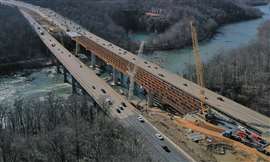 To alleviate congestion along Interstate 95 JMT was contracted to deliver six miles of new southbound lanes and four bridges. (Image: JMT)
To alleviate congestion along Interstate 95 JMT was contracted to deliver six miles of new southbound lanes and four bridges. (Image: JMT)
To alleviate congestion along Interstate 95 (I-95) across the Rappahannock River in Fredericksburg, Virginia, US, JMT – a US-based construction and engineering firm – was contracted to deliver six miles of new southbound lanes and four bridges.
The design included complex plans to maintain traffic during construction and was subject to strict environmental requirements.
“Some roadways are just notorious for congestion,” said Garth Donahue, JMT’s director of the Design Center of Excellence.
Previous attempts to renovate one of the busiest roadways in the United States had failed, with Donahue saying “political, environmental and historical considerations” held up repairs in the past.
JMT decided a digital approach could help iron out the project’s issues and selected Bentley Open applications to model the existing roadway, proposed designs and construction plans.
“VDOT [the Virginia Department of Transportation] required a BIM execution plan and certain model deliverables be part of the final product,” added Donahue, noting that the bridge aspects of the project required unique digital planning. “With the model built, the team was able to bring it to life using LumenRT.”
Integrating Bentley LumenRT produced clear, immersive animations, said JMT, which aided stakeholder and public understanding and engagement.
Advanced modelling and simulation features also allowed JMT to effectively assess traffic management and the sustainability of the new roadway designs, identifying and resolving issues early on to save time and resources, as well as minimise community and environmental impact.
JMT said the 3D models and simulations could help shorten construction time and minimise future roadway repairs. Donahue said the project was delivered on-time and on-budget.
Bentley software used: Bentley Descartes, Bentley Infrastructure Cloud, Bentley LumenRT, iTwin, iTwin Capture, iTwin Experience, iTwin IoT, MicroStation, OpenBridge, OpenCities, OpenFlows, OpenRoads, ProjectWise
Construction
Winner: Proicere
Project: SPRS Retreatment Plant Sellafield
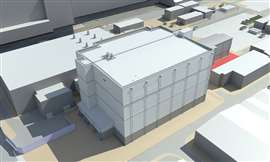 Working in a connected digital platform, the team established a digital twin to perform construction simulation, streamlining workflows, and mitigating more than160 potential risks. (Image: Proicere)
Working in a connected digital platform, the team established a digital twin to perform construction simulation, streamlining workflows, and mitigating more than160 potential risks. (Image: Proicere)
The Sellafield Retreatment Plant (SRP) in Seascale, Cumbria, England, is part of the UK’s Nuclear Decommissioning Authority’s (NDA) initiative to gradually transfer, repackage, and safely store 127 tonnes of separated plutonium for 100 years.
Proicere – a UK-based BIM and project controls integration consultant – is delivering the scheme subject to complex regulatory requirements and stringent safety standards. To meet these criteria, and coordinate multiple disciplines and interfaces amid schedule pressures, Proicere needed a collaborative digital solution for optimal planning, execution and monitoring.
The firm leaned on Bentley’s SYNCHRO for 4D planning and scheduling, which has allowed the team to digitally visualise, plan and execute the complex site works. Working in a connected digital platform, they established a digital twin to perform construction simulation, streamlining workflows, as well as identifying and mitigating more than160 potential risks.
According to Proicere, the digital solution has already saved nearly $100 million in costs and avoided more than 500 days of rework.
Dan Ashton, Proicere technical director and BIM specialist, noted cost savings were not the main goal. Instead, security and environmental protection were top priorities, which he also believed have been delivered with the digital solutions.
“It has a lot of risk associated with the grounds and sites and other nuclear operations going on around the site. Our primary purpose was to support the timely delivery with no compromise on quality,” said Ashton during presentations. “So cost, while still important, was not the driving factor behind this project.”
The technologically complex project won’t be finished for decades and is projected to cost around $1.5 billion.
Bentley software used: iTwin, SYNCHRO
Enterprise Engineering
Winner: Mott MacDonald and HDR
Project: Ontario Line Information Management
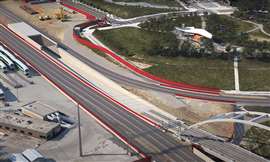 The project used Bentley software such as Bentley LumenRT, iTwin, ProjectWise, and SYNCHRO (Image: Mott MacDonald and HDR)
The project used Bentley software such as Bentley LumenRT, iTwin, ProjectWise, and SYNCHRO (Image: Mott MacDonald and HDR)
The Ontario Line is a new subway in Toronto, Canada, that will help transform public transit across the city.
Construction consists of installing 15.6km of new railway infrastructure and 15 new stations.
A consortium of UK-based consultants Mott MacDonald and US-based professional services firm HDR used ProjectWise reduced time to access files by 50% while also saving 15 hours per week in checking and reporting file status. Working together as a combined technical advisor, Mott MacDonald and HDR had to efficiently manage and share reliable data across multiple contracted organizations.
The teams used the iTwin Platform to provide quick, web-based access to the latest models, while ProjectWise served as the connected data environment.
SYNCHRO and Bentley LumenRT helped improve 4D modelling and visualization capabilities, improving communication with the team and third-party stakeholders.
“By using SYNCHRO, the team was 60% more efficient with their constructability and scheduling meetings,” said the JV. “When complete, the Ontario Line is expected to take 28,000 cars off the road, saving 7.2 million litres of fuel annually.”
Matthew Lane, senior principal and digital consultant at Mott MacDonald, noted the sprawling project involved dozens of stakeholders and infrastructure companies, which can complicate communications. The team relied on digital planning to navigate the environment.
“One of the key challenges faced by [this] project is the sheer number of interfaces that need to be managed and coordinated efficiently,” said Lane. “To manage a programme of this scale and complexity, the design and construction for the scheme is being delivered across a number of different contracts.”
The nearly $20-billion project is scheduled for completion in 2031.
Bentley software used: Bentley LumenRT, iTwin, ProjectWise, SYNCHRO
Facilities, Campuses, & Cities
Winner: China ENFI Engineering Co.
Project: Comprehensive Waste Management Facilities in Xiong’an New Area
 The 220,000m2 Comprehensive Waste Treatment Facility Project of Xiong’an, China, aims to make the area a “waste-free city.” (Image: China ENFI Engineering Co.)
The 220,000m2 Comprehensive Waste Treatment Facility Project of Xiong’an, China, aims to make the area a “waste-free city.” (Image: China ENFI Engineering Co.)
The Comprehensive Waste Treatment Facility Project of Xiong’an, China, aims to make the area a “waste-free city.”
The 220,000m2 facility will process 2,776 tonnes of garbage, kitchen waste, solid sewage, and medical waste per day, while converting that material into energy.
“This process will be invisible to residents, as the facility will be underground and topped by a park,” said designer China ENFI Engineering Co. (ENFI). This aspect, the company said, added challenges to designing ventilation, navigating tight spaces for equipment, in fire protection, seepage control all while expected to deliver on a short schedule.
To navigate the project, the team moved away from 2D concepts to digital design using Bentley applications, unifying all collaborators among 13 design specialties to help determine how to overcome challenges via 3D modelling and construction simulation.
“In the process, they improved efficiency by 130% and greatly reduced errors. In addition to effectively building within curved mountainous terrain, they eliminated the need for four cranes and avoided rework, saving nearly $2 million,” said ENFI.
Planning construction sequences in advanced also reduced construction time by 50 days, ENFI said. Additionally, ENFI said it discovered 6,934 potential issues ahead of construction using the model and produced more than 13,000 drawings from it.
An overall value for this specific project was not available nor was a date of completion. The entire Xiong’an New Area programme, meant to reimagine the region as a modern smart city, is expected to cost around $100 billion and finish in 2049.
Bentley software used: AutoPIPE, Bentley Descartes, Bentley LumenRT, Bentley Raceway and Cable Management, iTwin, iTwin Capture, MicroStation, OpenBuildings, OpenPlant, OpenRoads, ProjectWise, ProStructures, SYNCHRO
Process & Power Generation
Winner: PowerChina Zhongnan Engineering Corp.
Project: Digital Twin of Shandong Energy Group Bozhong Offshore Wind Farm
 The Bozhong Offshore Wind Farm is the first grid-parity offshore wind farm project in Shandong, China. (Image: PowerChina Zhongnan Engineering Corporation Limited)
The Bozhong Offshore Wind Farm is the first grid-parity offshore wind farm project in Shandong, China. (Image: PowerChina Zhongnan Engineering Corporation Limited)
The Bozhong Offshore Wind Farm is the first grid-parity offshore wind farm project in Shandong, China, and involves the intersection of submarine cables and oil and gas pipelines.
Upon completion, the facility will provide 1.7 billion KWh of electricity to the grid annually, which PowerChina believes will reduce carbon emissions by 1.14 million tonnes.
The project presented complex hydrological and geological site conditions, required cost-efficient design solutions, and involved coordinating multiple stakeholders on a tight timeline, said PowerChina Zhongnan.
The company said the integrated technology approach reduced modelling time by 30%, shortened the construction period by 20%, and saved 10% in costs.
The team used integrated tech solutions, including leveraging Bentley’s open 3D modelling software with ProjectWise. The teams established a collaborative digital environment, BIM models, and a digital twin to realize automated design and intelligent workflows and delivery.
The programme cost nearly $750 million to construct and was commissioned in late 2022.
Bentley software used: Bentley Raceway and Cable Management, MicroStation, OpenBuildings, OpenPlant, OpenRoads, OpenWindPower, PLAXIS, ProjectWise, ProStructures
Rail & Transit
Winner: SPL Powerlines UK
Project: Midland Main Line Electrification
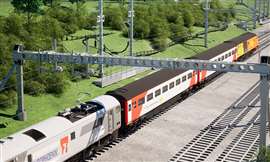 SPL used ProjectWise as the basis for its connected data environment, sending and receiving information from 20 design organisations on the projec. (Image: SPL Powerlines UK)
SPL used ProjectWise as the basis for its connected data environment, sending and receiving information from 20 design organisations on the projec. (Image: SPL Powerlines UK)
The Midland Main Line Electrification (MMLE) Programme across England, UK, is a multidiscipline infrastructure project implemented to increase capacity and provide a full overhead electrified rail route from London.
SPL Powerlines UK was tasked with installing 447km of single track overhead line along the rail corridor.
“However, the scheme was divided into eight route sections that SPL needed to manage across a multidiscipline team. Therefore, they needed to ensure that everyone had access to the latest design information,” said SPL Powerlines on why teams opted for a digital software solution.
Elliot Watson, SPL’s head of engineering services, said 39 subcontractors were integrated into the scheme.
“One of the complex things we got to deal with on this project, [the subcontractors] are all different designers with different disciplines… and they’re all at difference phases at any one time, so what we’re trying to do is create an integrated design,” said Watson.
SPL used ProjectWise as the basis for its connected data environment, sending and receiving information from 20 design organisations on the project. They also created an iTwin for further improved visibility of all design data.
Portions of the overall $1-billion programme have finished, with the entire electrification project expected complete in the early 2030s.
Bentley software used: AssetWise, Bentley Descartes, Bentley LumenRT, iTwin, iTwin Capture, MicroStation, OpenRail, Pointools, ProjectWise
Roads & Highways
Winner: Department of Public Works and Highways (Philippines)
Project: Digital Twin Implementation for NLEX-SLEX Connector Road Project
 The project in Manilia develop a mixed reality digital twin. (Image: Department of Public Works and Highways)
The project in Manilia develop a mixed reality digital twin. (Image: Department of Public Works and Highways)
Manila, Philippines, is one of the most densely populated metro areas in the world and suffers from significant road congestion.
To improve the situation, the Philippines’ Department of Public Works and Highways (DPWH) is developing an 8km, all-elevated, high-speed road connecting major road networks in Manila’s north and south regions.
“Developing roads in a dense urban centre presented challenges, including right-of-way issues and limited space for construction equipment,” acknowledged DPWH.
After considering several technologies, DPWH said it chose Bentley solutions to develop a mixed reality digital twin of the project. Using iTwin Capture, project managers incorporated conditions in the field, then using OpenBridge and OpenRoads to create 3D models.
With Bentley LumenRT and SYNCHRO, they visualized the construction process, which DPWH said increased productivity by 15% and boosted equipment logistics by 40%.
The new road improved transportation travel time between the city’s northern and southern motorways by more than one hour; a staggering drop to just 20 minutes from nearly two hours.
James Nicole Chavez, DPWH engineer for public-private partnership service, told Construction Briefing that achieving the massive highway construction would have been possible with 2D design and development, but it would have been too costly with time and finances to make it worth it.
“A personal opinion, I think it would still be possible, but it would take ages to implement,” he said. “The introduction of 4D and 3D modelling really helped us identify specific areas for special consideration.”
Chavez said the project is more than 90% complete with hopes to finish later this year. It’s expected to cost around $404 million.
Bentley software used: Bentley LumenRT, iTwin Capture, OpenBridge, OpenRoads, SYNCHRO
Structural Engineering
Winner: Hyundai Engineering
Project: New Physical Modeling Method for Plant Steel Structures Using STAAD API
 Hyundai Engineering initiated a project to automate structural design processes. (Image: Hyundai Engineering)
Hyundai Engineering initiated a project to automate structural design processes. (Image: Hyundai Engineering)
To help engineers avoid repetitive tasks and foster creative, more efficient design of plant steel structures, Hyundai Engineering initiated a project to automate structural design processes.
The group wanted to develop a novel physical modelling method and generate an analytical digital twin. However, with numerous design variables that can be mismatched and deliver unreliable assessment results, Hyundai said it realised it needed comprehensive structural modelling and analysis technology to optimally consider constructability enhancements.
The South Korean-based firm selected Bentley’s STAAD to apply design automation techniques to a plant steel structure on a sample project.
“Bentley’s application enhanced structural design efficiency, reliability, and quality, as well as optimised design while considering constructability,” said Hyundai.
The company added, based on the total steel volume in their sample project, the digital solution reduced structural analysis time by 70% and design errors by 50% and was expected to save approximately $243,000.
Bentley software used: STAAD
Subsurface Modeling & Analysis
Winner: Spark consortium and WSP
Project: North East Link Central Package
 The North East Link will improve connectivity in the city of Melbourne’s freeway network. (Image: Spark and WSP)
The North East Link will improve connectivity in the city of Melbourne’s freeway network. (Image: Spark and WSP)
The Australian state of Victoria’s ‘largest’ infrastructure project – the North East Link – will improve connectivity in the city of Melbourne’s freeway network, removing 15,000 trucks from congested roads by installing 6.5km of three-lane, underground twin tunnels.
The project is helmed by a consortium of international firms called Spark, which include digital modelling and communication led by WSP.
Successful delivery of the project required Spark’s engineering design team to bring in seven design consultancies, including WSP, for the complex geological site conditions and risks, the consortium said.
“To rapidly model, capture, visualise, and integrate the voluminous ground engineering data for multidisciplinary design evaluation, the team needed flexible, comprehensive geotechnical software and a connected data environment,” said Spark.
Using Leapfrog, PLAXIS, and ProjectWise, WSP developed, refined, and delivered 3D subsurface models that were integrated into the federated project model for design analysis and construction planning.
Working in a connected digital platform, the project streamlined workflows and saved 1,500 hours in collaborative modelling, the consortium estimated.
“Through comprehensive geotechnical modelling, the team optimised risk management and design compliance, saving $4 million, and were able to recycle excavation materials, saving an additional $6.7 million,” said Spark.
The 3D geological models will be incorporated into the digital twin to support tunnel operation and emergency management. The project is expected to cost just less than $10 billion and finish in 2028.
Bentley software used: GeoStudio, Leapfrog, OpenRoads, PLAXIS, ProjectWise
Surveying & Monitoring
Winner: Water Supplies Department (Hong Kong)
Project: Digital Twin of the Ex-Sham Shui Po Service Reservoir
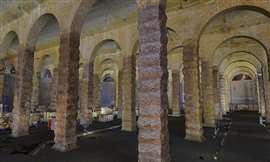 LSS utilized Bentley’s iTwin applications to process drone-captured and scanned images into a mesh model and digital twin. (Image: Water Supplies Department)
LSS utilized Bentley’s iTwin applications to process drone-captured and scanned images into a mesh model and digital twin. (Image: Water Supplies Department)
Built in 1904, the Ex-Sham Shui Po Service Reservoir formed part of the Kowloon Waterworks Gravitation Scheme near Hong Kong until it was decommissioned in 1970.
The structure was declared a Grade I historic building by the government in 2021, which prompted a digital approach to understand future management of the 120-year-old structure.
Given its historical background as a crucial water supply building, coupled with its iconic design and architecture, Land Surveying Section (LSS) of the Water Supplies Department (WSD) of Hong Kong was tasked with constructing a digital replica to preserve the historic nature of the structure that today attracts numerous tourists.
The project presented data capture, integration, and exchange challenges on a tight project timeline, requiring a unified platform to model and share the multisource data with numerous stakeholders.
LSS utilized Bentley’s iTwin applications to process drone-captured and scanned images into a mesh model and digital twin. Working in a cloud-based platform streamlined sharing data with multidisciplined stakeholders, improving data exchange efficiency by 30%, WSD said.
“The automated and robust features of iTwin reduced data processing time by 20% and increased the model accuracy by 50%,” added WSD. WSD called the project a “pilot” for future historic infrastructure preservation in the region.
Bentley software used: Bentley LumenRT, iTwin Capture, MicroStation, OpenBuildings
Transmission & Distribution
Winner: Southwest Electric Power Design Institute Co. of China Power Engineering Consulting Group
Project: Full Life Cycle Digital Applications of Butuo ±800kV Converter Station
 Due to the site’s location and environmental conditions, an integrated design model was developed to help all stakeholders understand the complex project. (Image: Southwest Electric Power Design Institute Co. of China Power Engineering Consulting Group)
Due to the site’s location and environmental conditions, an integrated design model was developed to help all stakeholders understand the complex project. (Image: Southwest Electric Power Design Institute Co. of China Power Engineering Consulting Group)
The Butuo ±800kV converter station transmits electric energy generated by the Baihetan Hydropower Station to the economically developed areas of eastern China.
Construction of the station was the first step in the nearly $5-billion Baihetan-Jiangsu UHV DC Power Transmission Line project, which became operational in late 2022.
The energy delivered by the station is expected to meet annual electricity demands for 75 million people and reduce coal consumption by more than 24 million tonnes.
Leveraging ProjectWise and Bentley Open applications, the team established a connected digital environment for collaborative design and construction management.
“Through 3D modelling and visual planning, [the project] reduced total land used for the station by about 10 hectares to save $6 million,” said SWEPDI. “Working in an integrated digital ecosystem reduced design time by 30 days, shortened the construction period by 40 days, and saved approximately $1 million in overall project costs.”
SWEPDI electrical engineer and BIM team core member Yang Lingshuang noted the converter station alone involved an investment worth $1.6 billion.
She said, due to the site’s location and environmental conditions, an integrated design model was developed to help all stakeholders understand the complex project and plan ahead for potential challenges.
Bentley software used: Bentley LumenRT, MicroStation, OpenBuildings, OpenSite, OpenUtilities Substation, ProjectWise, STAAD
Water & Wastewater
Winner: Basic Sanitation Utility Company of São Paulo-Sabesp
Project: Integra 4.0 Cultural transformation through Digitalization
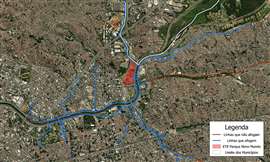 Known as Integra 4.0, the programme is an operational management model, combining business intelligence with AI for proactive network monitoring. (Image: Basic Sanitation Utility Company of the State of São Paulo – Sabesp)
Known as Integra 4.0, the programme is an operational management model, combining business intelligence with AI for proactive network monitoring. (Image: Basic Sanitation Utility Company of the State of São Paulo – Sabesp)
To ensure reliable access to clean water across 375 municipalities in São Paulo, Brazil, city-owned Sabesp – a water and waste management company – initiated a project to integrate water supply, sewage, and sanitation data in a single digital environment.
Known as Integra 4.0, the programme is an operational management model, combining business intelligence with AI for proactive network monitoring and maintenance to quickly identify and resolve system issues.
“Faced with land use, technical, and coordination challenges on a short timeline, Sabesp needed integrated hydraulic modelling and analysis software to develop their systemic approach,” said the firm. “Leveraging OpenFlows applications, Sabesp… monitored leaks and wasted resources, enabling integrated, accurate, and efficient management of water resources and assertive maintenance of network infrastructure.”
The company added, within a seven-month period, the digital solution saved approximately $555,000 in corrective maintenance “achieving a 30% reduction in corrective services to save 2,800 hours in field work.”
Bentley software used: OpenFlows
CONECTAR-SE COM A EQUIPE





